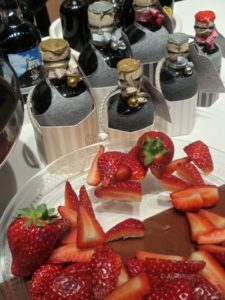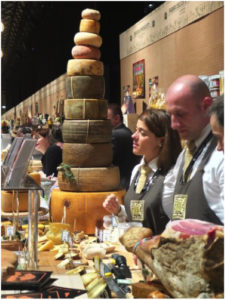
Cheese Master Andrea Magi, sister-in-law Jade Lucci constructed their own 11-wheel Leaning Tower
Ever been to a trade show? If so, you know they’re oppressive: they reek of relentless deal-making; of order forms, checkbooks, credit cards and PayPal, with Apple Pay soon to join. Buyers and sellers seem to have few interests beyond prices and delivery dates, which is one reason, in the U.S., Las Vegas is the most popular venue. As for the companies involved, the big guns conquer the hall with multi-acre pavilions while the popguns lurk in pup tents on the sidelines, drawing little attention save from people looking for the restrooms.
Nevertheless it was in a state of nearly giddy anticipation that I plunged into Pitti Taste in Florence. That’s because it wasn’t Florence, North Carolina, the other Carolina or, say, Idaho (there are dozens of them in the U.S.) but Florence, Italy. After all, the E=mc2 of foodie equations is Italy + Food = Glory2.
The event was staged or celebrated (like a mass) March 12-14, 2016 in Stazione Leopolda, the city’s old train terminal, which has been converted into a space for what Italians call eventi. It’s just a 15-minute walk or 3-minute tram ride from the new one, Santa Maria Novella, in the heart of the city. When I got there, as Fats Waller used to say, the joint was jumpin’.
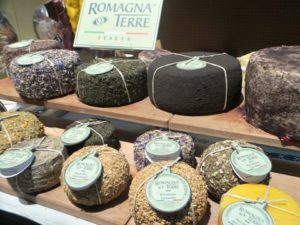 There were several reasons for that, but two were over-archingly important. The first is that of the nearly 350 exhibitors, all but a handful were small- and medium-size concerns: mostly family-owned companies producing top-quality specialty foods that are, to use properly a word much abused, artisanal. Their mantras are biologico (organic), pesticide-free and no OGM (GMOs). As a group they trace a grand timeline of Italy’s heritage of fine food. A few of the companies were born yesterday, so to speak, and that augurs well for the future. Very many more go back to the beginning of the last century and a few sturdy survivors are dramatically, even stunningly older. Acetaia Leonardi, for example, began making balsamico tradizionale (which is the real McCoy, not the supermarket stuff) about the same time as the Tamborini Frisari clan began pressing olive oil: that is, the early 1700s. Impressive, but both were preceded in the same vocations by Giuseppe Giusti (1605) and De Carlo (1600). Trumping them all is the famiglia Gonnelli. They have produced oil in Reggello, southeast of Florence, since 1585 at their Santa Tea frantoio (oil press). Johnny-come-latelies, those Gonnellis: Santa Tea itself is documented as far back as 1426.
There were several reasons for that, but two were over-archingly important. The first is that of the nearly 350 exhibitors, all but a handful were small- and medium-size concerns: mostly family-owned companies producing top-quality specialty foods that are, to use properly a word much abused, artisanal. Their mantras are biologico (organic), pesticide-free and no OGM (GMOs). As a group they trace a grand timeline of Italy’s heritage of fine food. A few of the companies were born yesterday, so to speak, and that augurs well for the future. Very many more go back to the beginning of the last century and a few sturdy survivors are dramatically, even stunningly older. Acetaia Leonardi, for example, began making balsamico tradizionale (which is the real McCoy, not the supermarket stuff) about the same time as the Tamborini Frisari clan began pressing olive oil: that is, the early 1700s. Impressive, but both were preceded in the same vocations by Giuseppe Giusti (1605) and De Carlo (1600). Trumping them all is the famiglia Gonnelli. They have produced oil in Reggello, southeast of Florence, since 1585 at their Santa Tea frantoio (oil press). Johnny-come-latelies, those Gonnellis: Santa Tea itself is documented as far back as 1426.
As individuals the producers struck me salt-of-the-earth, grass-roots, down-to-earth people; there wasn’t a Brioni suit amongst them. Instead it was their family history that they wore with pride. All had their stories of modest 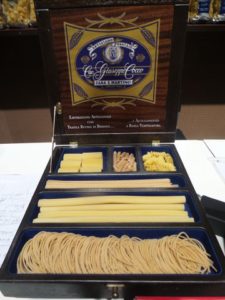 beginnings (often with bisnonno e bisnonna — the great-grandparents), later struggles during wars and economic downturns, determined commitment to quality, and of how in the end they not only survive but thrive and perpetuate their values in a universe of supermarket titans. And of course the people telling those stories almost always were actual family: husbands and wives, sons and daughters, brothers and sisters, cugini (cousins) and in-laws were on hand by the long ton. That made the point abundantly clear: it’s the personal touch that is all: everything from maintaining tradition to upholding standards to clearing the shelves. Once you’ve spent a few minutes with the Martellis of Pisa and learned why they make only penne classiche (the plain ones) and adamantly reject the ribbed penne rigate, or heard one of the Canossa family of Ferrara passionately proclaim “We do not stress our pasta,” well — you’re bonded, simple as that. As Pitti Taste director Lapo Cianchi likes to say, “Every little bite tells a story.”
beginnings (often with bisnonno e bisnonna — the great-grandparents), later struggles during wars and economic downturns, determined commitment to quality, and of how in the end they not only survive but thrive and perpetuate their values in a universe of supermarket titans. And of course the people telling those stories almost always were actual family: husbands and wives, sons and daughters, brothers and sisters, cugini (cousins) and in-laws were on hand by the long ton. That made the point abundantly clear: it’s the personal touch that is all: everything from maintaining tradition to upholding standards to clearing the shelves. Once you’ve spent a few minutes with the Martellis of Pisa and learned why they make only penne classiche (the plain ones) and adamantly reject the ribbed penne rigate, or heard one of the Canossa family of Ferrara passionately proclaim “We do not stress our pasta,” well — you’re bonded, simple as that. As Pitti Taste director Lapo Cianchi likes to say, “Every little bite tells a story.”
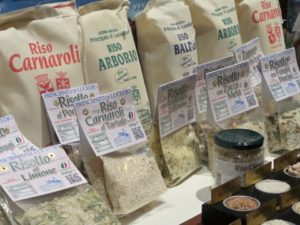
Different varieties of rice
And I do mean you. The second key to Pitti Taste’s great success is public access. Most trade shows exclude the public until the last day, when half the exhibitors are packing for home and the rest have already left. Pitti Taste is open to the public every afternoon, and the result was a veritable Arno of visitors. Many of them wanted to meet producers they knew only through their products; others were on the hunt for new, obscure brands and tastes and other Holy Grails of the foodie tribe; but all indulged in the staggering array of tasting samples. Staggering because almost every exhibitor offered several.
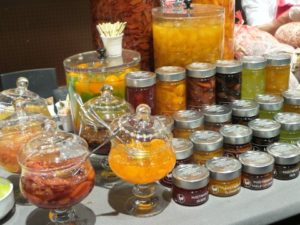 In the interest of journalism, Hungry Reader, I did, I confess, graze. The cornucopia was of such abundance that I was forced to omit specialties that I already knew well, with certain and rather frequent exceptions for the likes of salumi, olio d’oliva, gelato, jams and preserves, prosciutto, chocolate, Taggiasca and Tonda Iblea olives, mortadella, pasta asciutta, and dried and candied fruits. Instead I concentrated on the unusual delights. Ventricina, for example, is a highly spiced pork sausage cooked in a pig’s stomach and spread on toast à la bruschetta, but Enrico Fracassa’s ventricina is the only one specific to Teramo, in the Abruzzi. That of course led to other treasures and pleasures, such as Parmigiano-Reggiano from red, brown and even post-partum cows; a goat cheese from Friuli-Venezia Giulia called Zoncalon di Capra, and fossa cheeses, which are
In the interest of journalism, Hungry Reader, I did, I confess, graze. The cornucopia was of such abundance that I was forced to omit specialties that I already knew well, with certain and rather frequent exceptions for the likes of salumi, olio d’oliva, gelato, jams and preserves, prosciutto, chocolate, Taggiasca and Tonda Iblea olives, mortadella, pasta asciutta, and dried and candied fruits. Instead I concentrated on the unusual delights. Ventricina, for example, is a highly spiced pork sausage cooked in a pig’s stomach and spread on toast à la bruschetta, but Enrico Fracassa’s ventricina is the only one specific to Teramo, in the Abruzzi. That of course led to other treasures and pleasures, such as Parmigiano-Reggiano from red, brown and even post-partum cows; a goat cheese from Friuli-Venezia Giulia called Zoncalon di Capra, and fossa cheeses, which are
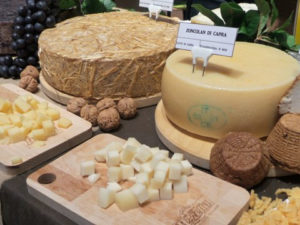
Zoncalon di capra
buried in sealed pits for months of aging and fermentation. Not just prosciutto but Nello and Marina Meggiolaro’s roasted prosciutto, bone in and with its rim of fat soft as custard, as well as porchetta that could make you weep. Goose salami, spicy Calabrian ‘nduja and Fattoria di Parma’s lumpy Felino di San Antonio, which must be sliced thin and at an angle of 60° (as all salami should be, in my opinion). Barrel-aged anchovy sauce; quarter-century-old balsamico tradizionale; homely and huge Pera d’Abruzzo tomatoes reduced to a sauce that I could have drunk out of the bottle, plus at least four Ligurian pestos that I could have spooned straight from the jar. Not to mention hand-rolled taralli, peasant breads the size of sofa cushions and others from Pane Piume, which are made from orphaned, abandoned or nearly extinct heirloom wheat varieties (all of them perfect with the many mountain-grown jams and preserves offered by Agrirape of Sicily and others ). Then there was bamboo-baked pastry and panettone made by rehabilitating inmates of a prison in Padua. I could go on. In fact, I did: straight to a Piemontese treat from Barbero of Cherasco delightfully named Sins of the Cardinal.
Nearly 50 makers of craft beer (it’s big in Italy these days), wine, grappa, liquori and Rossa’s blood-orange digestivo provided the essential lubricants inside the main hall, but there was more outside in the rear. Indeed, Pitti Taste, which is the child of events producer Pitti Immagine (known also for its famous menswear show) and fostered by Paolo Castagna and others of the Italian Trade Commission, has had to expand. For this 11th exhibition it took over an outdoor court and the ‘Taste Ring,’ a space borrowed from Florence’s opera. The Ring is dedicated to food seminars open to all and to a pop-up restaurant offering light lunches, snacks and drinks to anyone not already sated by samples.
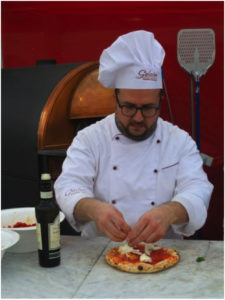
Pizzaiolo Pasquale Laterza advises adding the mozzarella di bufala only after the pizza is baked, just before serving
Between the Ring and the main hall, the court had its own seductions. One was the Spazio Fumoir, where women as well as men settled the digestion with a combination of 15-year-old oak-aged Nardini grappa and hand-rolled Toscano cigars. These cigars, made from fermented Kentucky-seed pipe tobacco, are familiar to many from Clint Eastwood’s spaghetti westerns. The other was the open-air Neapolitan pizzeria, which did a land-office business. Seeking advice about my own pizza-making, I asked a pizzaiolo for help. Chef Pasquale Laterza surprised me by saying that when using real mozzarella di bufala, I shouldn’t put it in the oven: I should bake the pie with sauce only and not add the bufala until afterward. Then he made me a pizza according to that principle, and it knocked me flat.
For those with the necessary stamina there were other doings, including a charity auction of rare and collectable cookbooks, a cookbook store and, best of all, a retail store. This, devoted exclusively to exhibitors’ products, made it possible to take some of the fair’s seductions home (many of the smaller exhibitors have only spotty distribution in Italy; sometime even within their home regions). As I had rented an Airbnb flat with a well-equipped angolo di cucina (kitchenette), I did just that, and I packed a lot more to take home. At the airport, my luggage was this-close to being flagged as overweight.
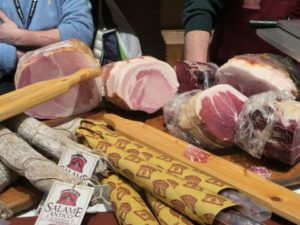
IF YOU GO: Next year’s Pitti Taste will be held March 11-13, and again it will be at Stazione Leopolda. Tickets are priced at €20 daily, available online:
http://www.pittimmagine.com/en/corporate/fairs/taste/information.html.
The price includes a copy of the nearly 400-page Guide, which is an invaluable resource that provides contact information, product lists and brief profiles of all exhibitors. If possible, it should be picked up a day or two early. Poring over it beforehand enables focusing on areas and producers of maximum interest. In addition, it’s a good idea to check the event’s online “Fuori di Taste” calendar for the dozens of events, staged in concert with Pitti Taste but not officially part of it, that are presented by many Florence restaurants. These may begin as early as March 7.
